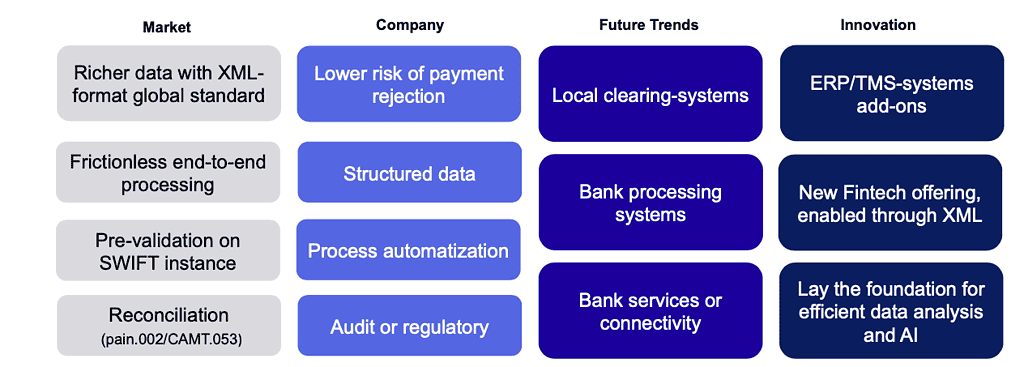
The Shift to XML
The global move toward XML isn’t just driven by Swift; it represents a broader industry shift affecting a wide range of digital payment players, including financial institutions, clearing systems, intermediaries, ERP and TMS. New TMS/ERP add-ons and emerging fintech offerings will predominantly be based on XML.

XML is becoming the new global language for payments and statements, ensuring compliance and unlocking numerous benefits and future services.
For example, some banks mandate structured addresses before November 2026. While message type (MT) formats can fulfill these requirements, conversions will incur costs for corporations, many of which lack the necessary data and thus require significant updates. Switching to XML is strategic, addressing these requirements and offering enhanced data richness and faster processing. Embracing XML streamlines operations, reduces friction and positions corporations for a more efficient financial future.
The Swift Timeline and Adaptation
Swift’s commitment and June 2024 update reaffirm that November 2025 will be the end of the coexistence period, primarily focusing on instruction messages.
- Instructions messages (e.g., payments):
- Some MT messages will be withdrawn from FIN in November 2025.
- MT101 and MT103 sent via FIN over a Financial BIC (FI) will require validation and face increased charges starting November 2025, but do not have a set date of decommissioning. Service termination may depend on individual bank’ offerings.
- Non-Instructions:
- Reporting, charges, checks and direct debits will not be withdrawn from FIN in November 2025.
- MT940 and MT942 messages will continue via FIN over a FI BIC, depending on the bank’s service continuation.
- Corporate-to-Bank (Corporate BIC Owner/SCORE):
- No end of coexistence is planned.
- Usage guidelines are available on swift.com.
- Corporate BIC owners will be supported on FINplus starting November 2024.
Benefits of XML Adoption
XML offers enhanced interoperability, scalability, efficiency and future-proofing for businesses. In a globally and exponentially evolving technological economy, its flexible structure accommodates growth and facilitates seamless integration across platforms, laying the groundwork for leveraging emerging technologies, like AI.

Addressing Challenges
Transitioning to XML can overcome limitations of legacy systems, standardizing data formats and structures to improve efficiency and accuracy. This enhances financial evaluation and speeds up decision making at lower costs. XML also integrates easily with solutions like cash forecasting, cash pooling, automated reconciliation and refined parameters “on behalf of payments,” bringing Virtual IBAN capabilities to life.

Multibanking providers like Fides can further simplify the migration process, minimizing the impact of additional data requirements and ensuring compatibility across systems.
Completing the XML Evolution
The journey from legacy systems to XML is not a mere change; it represents an evolution that ensures your business remains dynamic and competitive. As financial institutions and corporations transition to XML, the benefits become clear: lower costs, enhanced data richness, faster processing, improved tracking and reconciliation, and unlocked new features and potential. Fides partners with corporates to embark on this vital evolution together and pave the way into the future.
